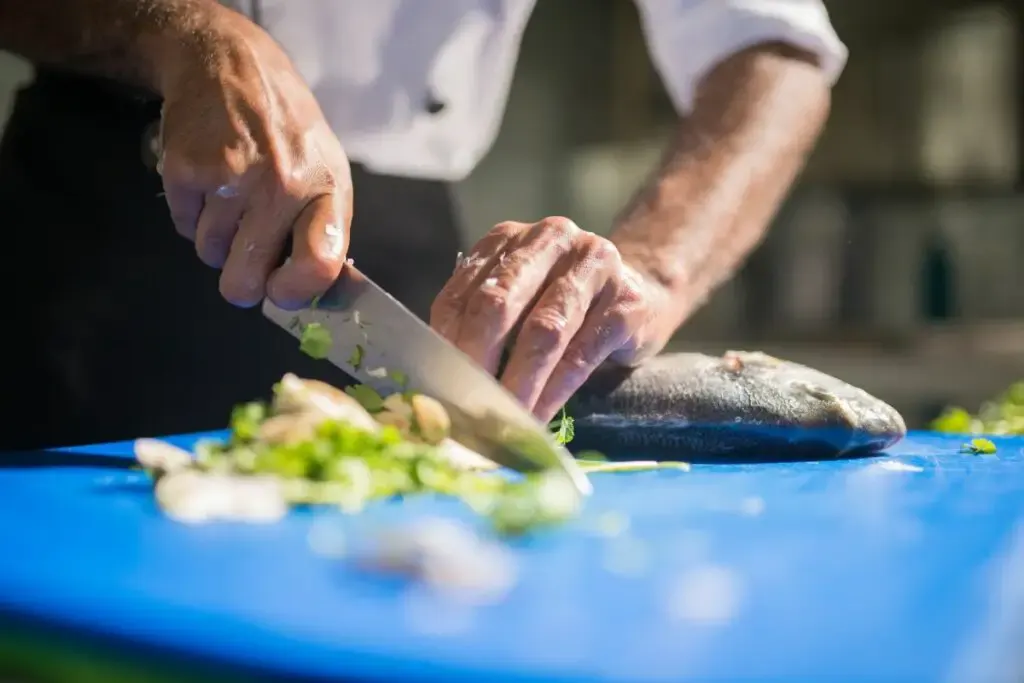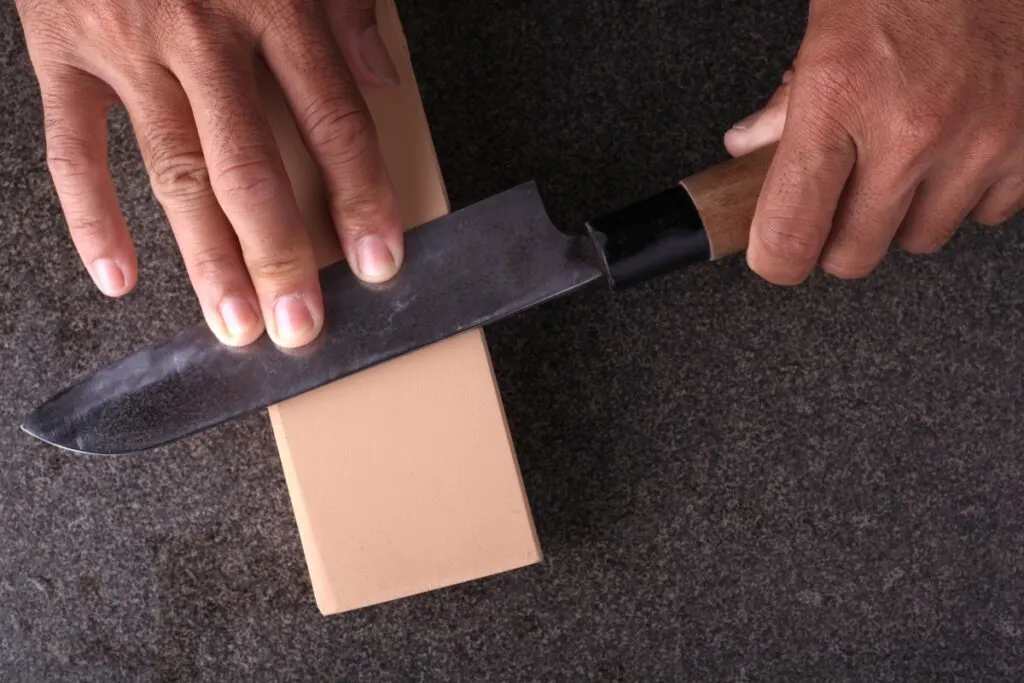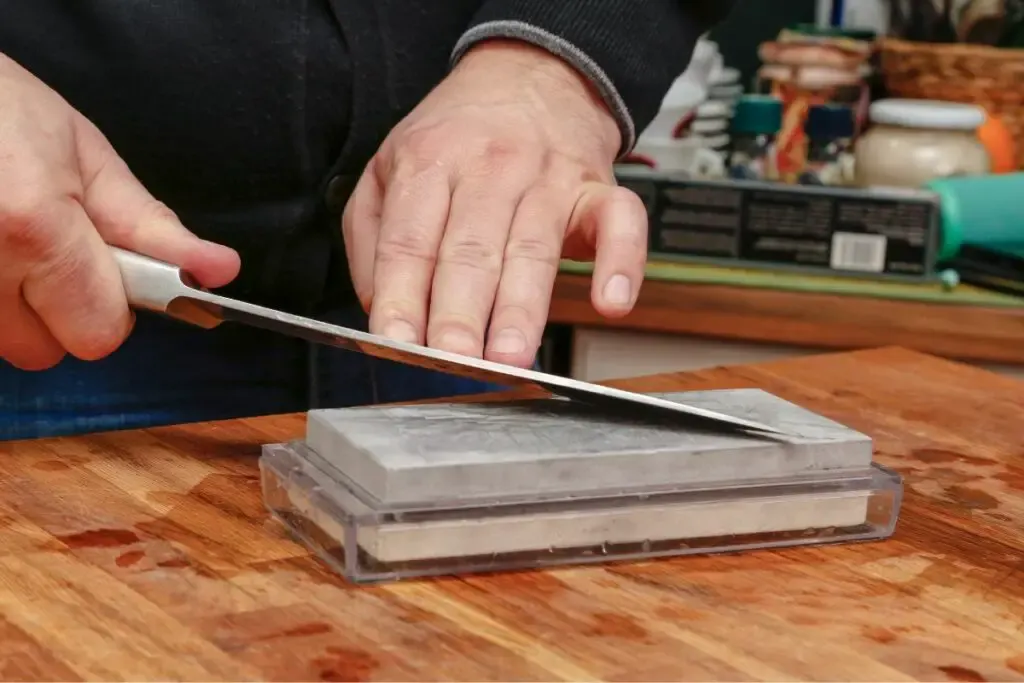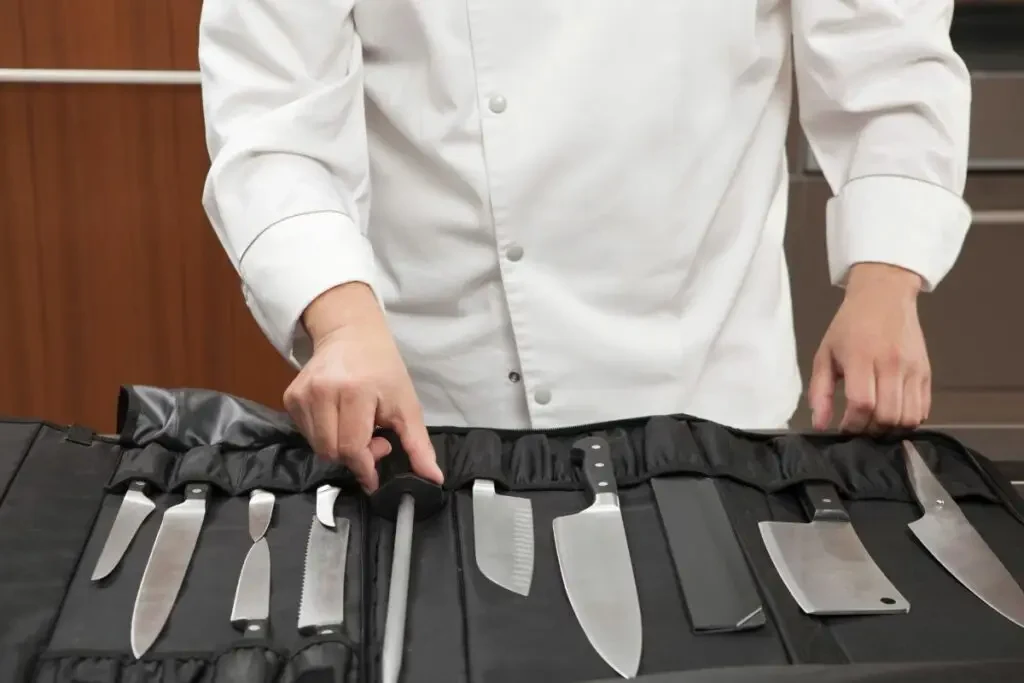As an Amazon Associate, we earn from qualifying purchases with no additional costs for you.
Experienced knife users say that a sharp knife is safer than one with a dull edge, which may sound counterintuitive initially, but there is merit to this statement. What are the reasons people hold this view, and are these valid?
Dull knives are more dangerous than sharp knives because of the additional pressure or force required to push the knife through the cut material. Most of the safety concerns stem from this action. Sharp knives can be dangerous if incorrect knife techniques are used.
Sharp knives are a pleasure to use and seem to work almost effortlessly when they have a keen edge. If you get your hand or finger in the way of a sharp knife, you will receive a nasty cut, probably worse than one a dull knife can inflict. So, how can a sharp knife be safer? Take a look at our tried and tested reasons why you are more likely to sustain an injury using a dull knife; it may change your mind!
If you are interested in checking out the best Japanese knives (made by Hayate Yoshihiro) we recommend and use, you can find them by clicking here (Amazon link).

Are Sharp Knives Safer Than Dull Knives?
If you have spent any time around people passionate about knives, you have probably heard them say that sharp knives are safer than dull knives.
What is the reasoning behind this statement, and is there any truth to it? On the surface, the statement may seem contradictory because a sharp knife can cut you more severely than a dull knife.
A knife’s purpose is to cut, chop, and slice, and a sharp edge makes it perform better, but does this make it safer for the knife user?
The following is our list of reasons that support the idea that sharp knives are safer to use, even though the sharp edge may be more dangerous.
1. People Are More Respectful Of A Sharp Knife
Have you noticed that people treat sharp knives with more respect? Knowing a knife is ultra-sharp changes your attitude toward the knife and how it is handled.
Sharp knives are retrieved from storage with more excellent care. Instead of reaching for the knife without looking, you keep your eyes on the knife till the handle is safely in your hands.
Handing a knife to another person is done with much more care when both parties realize the knife is extremely sharp.
Awareness of the knife’s sharpness increases the focus with which the knife is used and the care in how the knife is handled.
This reaction is natural for humans. When we are cognisant of danger, we are more focused and pay more attention to what we are doing than if we perceive the risk of danger is lower.
We are less blasé about our knife use when we know the knife has the potential to inflict a severe wound.
2. A Sharp knife Requires Less Force.
A sharp knife requires reduced force to cut through materials. When a knife is sharp, the keen edge cuts through the material rather than forcing its way through the material by the user applying additional force or pressure.
Using less force to make a knife do what it is supposed to do gives the knife user a greater degree of control when using the knife.
This means you are less likely to lose control of the knife and cause an accidental injury while cutting.
Using less force is safer for the knife user and causes less damage to the cut material. The additional pressure used to force a knife through a material or ingredient can damage the material or bruise the ingredients.
TIP: For many knife owners, sharpening their knives with a whetstone is the only way to go. Check out the complete step-by-step guide on how to sharpen a knife with a whetstone in the article below:
Step-By-Step GUIDE: How To Sharpen A Knife With A Whetstone
3. A Sharp Knife Is Held Correctly

If a knife is sharp and cuts easily, you will be more likely to hold it the way it was intended to be held and used.
The extra force required when using a dull knife causes the user to position their hands differently on the knife and the item being cut.
When a sharp knife is held correctly, without the need to use an unorthodox grip on the knife, your hands will be safely out of the way of the sharp edge during the cut.
Incorrect hand and finger positions when using a dull knife can be dangerous when the knife suddenly breaks through the material or the knife slips. These situations can result in the knife’s edge impacting your hand or fingers with significant force.
Even a dull knife can cut; when additional force is applied, it can seriously injure your hands and fingers.
TIP: Are you looking to buy a new whetstone? Check out our recommendations (we personally use the first three ones):
Our PRO choice whetstones combo (Amazon links):
- Fixing stone: Whetstone SHAPTON Ceramic KUROMAKU #320
- Sharpening stone: Suehiro CERAX soaking whetstone: Medium #1000
- Finishing stone: Whetstone SHAPTON Ceramic KUROMAKU #5000
Our budget choice (Amazon link): Sharp Pebble Extra Large Sharpening Stone Set
4. The Cut Direction is Easier To Control With A Sharp Knife
A sharp knife will also glide through materials more efficiently, which makes it easier to control the direction of the cut.
When the blade’s path moving through the cut object is predictable and reliable, you are less likely to have hands or digits in the cutting path of the knife edge. This can help prevent accidental cuts to your fingers or hands.
The additional pressure used to force a dull knife through a material can cause the material to fracture or break. The fracture can re-direct the blade and the cutting edge in an unpredictable direction and send the edge toward your hand or fingers.
TIP: When people start sharpening their own knives, they find some knives hard to sharpen. Check out why some knives are hard to sharpen in the article below:
5 Reasons Why Some Knives Are Hard To Sharpen & What To Do
5. Using A Dull Knife Causes Fatigue
Using a dull knife can also be more tiring, as it requires more effort to cut through materials. Extended use of a dull knife can lead to hand and arm fatigue.
As the muscles in your hands become tired, your grip on the knife becomes compromised and less secure.
This reduction in grip on the knife can result in the blade slipping or twisting in the cut and increases the risk of injury.
You could also lose control of the knife and drop it, which not only poses an increased risk of accidental injuries but can also damage the knife.
In contrast, sharp knives pass quickly through materials, requiring a more relaxed grip on the knife and less force to drive the knife through the material.
This reduces the effort to use the knife and allows for extended knife use with a lower risk of developing hand and muscle fatigue.
6. A Sharp Knife Is Less Likely To Jam In The Material

Have you ever had an experience where a knife jams halfway through a cut? What is the typical reaction? The most common reaction is to use more pressure to force the knife through the cut.
Another possible action is to attempt to withdraw the knife from the material. This action also requires lifting or pulling the knife with excessive force, which can cause the knife to release suddenly. This sudden release can lead to injury to others or yourself.
A sharp knife passes quickly through the material and is less likely to get stuck midway through the cut.
Of course, the possibility is always there that a sharp knife may become stuck in a cut. In this case, extra care should be exercised when extricating the knife, as the sharp edge can potentially cause more severe injuries.
TIP: Keeping your knives sharper for longer is not only convenient but can also help to extend the life of your knives. Find out more in the article below:
5 Simple & Proven Tips: Keeping Your Knives Sharp Longer
7. A Dull Knife Can Cause Strains And Sprains.
Repetitive use of a dull knife and the additional pressure and forceful grip required to use the knife can cause various joint, muscle, and tendon maladies.
Repetitive motion tasks, such as food prep in a kitchen with a knife, are known to place strain on the joints, tendons, and muscles used to perform these tasks.
Injuries such as tendonitis, carpal tunnel syndrome, strains, muscle cramps, and strains can result from using a dull knife for repetitive tasks.
A sharp knife used for repetitive knife work results in less strain on fingers, hands, wrists, and forearms, reducing the risk of these types of injuries.
PRO TIP: We personally use diamond plates by Atoma. They are quite expensive but of the top quality with very long service life.
The initial costs are higher but you have an option of buying replacing diamond skin for all Atoma plates. The costs of replacing diamond skin are much lower than the cost of buying a new diamond plate.
So if you are going to use diamond plates regularly and want to get the best quality on the market, check out the four Atoma diamond plates listed below (Amazon links).
- Atoma Diamond Sharpener Coarse Grade 140 Grit
- Atoma Diamond Sharpener Medium 400 Grit
- Atoma Diamond Sharpener Fine 600 Grit
- Atoma Diamond Sharpener Super Fine 1200 Grit
These 4 diamond sharpening stones are all you need to have for repairing or sharpening your knives.
8. A Sharp Knife Reduces Haste

A sharp knife allows the knife user to work faster and more accurately, giving more time to complete the tasks at hand.
This reduces the haste with which the knife is used, which lowers the risk of losing focus and making dangerous choices in how the knife is used to complete the job.
A sharp knife also allows the user to be more precise and accurate in their cuts, reducing the concern about making mistakes in the cut. This reduces the tension with which the knife is used, making for a calmer knife user, less likely to rush the cut, make mistakes, and lose focus on the knife.
A sharp knife requires fewer passes to cut completely through the material, allowing the user to complete the task faster and with less effort.
TIP: Most people own multiple types of knives, each with different sharpening requirements. Find out how often you should sharpen your knife in the article below:
How Often To Sharpen A Knife? (Answers For All Knife Types)
9. A Sharp Knife Is Less Likely To Slip
A sharp knife bites into the material being cut, and the initial cut goes deeper into the upper layers of the material.
This feature of a sharp knife makes it less likely that the knife will slip off the material when initiating the cut, placing your non-knife hand at risk of injury.
This aspect is essential when cutting glossy or slippery materials that naturally make the blade inclined to slip in the first part of the cut.
Once the initial cut has been made, the knife has a groove to fit into. This reduces the knife’s potential to slip and results in the knife user losing control of the blade.
10. Cuts From Sharp Knives Heal Better
Frequent knife users will have an accident with a knife at some point. The statistical odds are simply against you to remain injury-free when using sharp instruments in close proximity to your hands and fingers.
If you happen to cut yourself, sustaining a cut from a sharp knife is preferable to a dull one. The edges of a cut from a sharp knife are clean and precise.
The consequence of a clean cut is that it is easier to stop the bleeding, and the cut will heal faster and with less scarring.
The neat edges of the cut allow the flesh to join together more tightly, reducing the risk of bacteria gaining access to the wound and causing infection.
The edges of a cut sustained from a dull knife are more likely to be jagged, as it rips your flesh rather than slicing it. This cut takes longer to heal, with a more significant potential for infection. Stitches are more likely to be necessary to promote healing.
The main risk with a cut from a sharp knife is the depth of the cut, which can sever tendons and ligaments, making the injury more complicated and possibly requiring surgery.
TIP: Many knife owners are unsure about knife sharpening, which causes them to leave knives longer than they should before sharpening. Check out why it is essential to sharpen a knife before use in the article below:
4 Reasons Why It Is Important To Sharpen A Knife Before Use
Other Tips For Safe Knife Use
The sharpness of the knife is not the only factor to pay attention to for the safe use of a knife. Any knife, sharp or dull, can cause injury if safe knife practices and incorrect knife techniques are used.
One of the most important aspects of knife safety is to use the right knife for the job. Using a knife that is too big or too small for the task can result in accidents.
Another knife safety protocol is never to cut yourself. This principle can be applied when cutting an item in your hand or thinking about where the knife will go after a cut.
For example, if you are slicing a bagel in half, do not hold the bagel in the palm and thumb of your free hand and slice the bagel with the knife cutting towards your hand.
A safer technique is to place the bagel flat on your work surface and secure it in place with the palm of your free hand pressing on top of the bagel. Then, slice the bagel with the blade moving parallel to the work surface and under the palm of your free hand.
When you are halfway through the bagel, rotate the bagel slightly to continue the cut until the two halves have been separated. This technique does not place any part of your hand in the cutting path of the knife’s blade.
Another aspect is never using any part of your body, such as your leg, as a work surface. For example, when carving a piece of wood, some people rest the piece of wood on their thighs while they carve.
Carving knives are incredibly sharp, and if the knife slips or the wood separates along a weak spot, the knife can be deflected into your leg.
A sharp knife is never the only aspect of safe knife use. Safe and sensible knife practices must also be observed to create an overall safe environment when working with knives.
BTW: If you are interested in buying the best cutting board, you can find our recommendations below:
- The best overall: Virginia Kitchen Boys Cutting Board (Amazon link). This fantastic cutting board is made from sustainable walnut wood from the United States and brings almost perfect safety when cutting with your knives.
- Alternative: Yoshihiro Cutting Board (Amazon link). Professional traditional Japanese cutting board that chefs around the world use.
- Cheaper option: Shun Cultery Cutting Board (Amazon link). Another Japanese cutting board stands out, especially for its simplicity and affordable price.
Knife Care: Ensuring Longevity and Performance

While understanding the differences between sharp and dull knives is crucial, equally important is knowing how to maintain and care for your knives.
Proper maintenance not only extends the lifespan of your knives but also ensures they perform optimally during each use. Here are some essential tips to keep your knives in top condition:
1. Proper Storage
Storing your knives correctly is vital to prevent damage to their edges and to ensure safety. Avoid tossing them into a drawer where they can get banged up. Instead, use a knife block, magnetic strip, or individual blade guards.
This not only protects the knife’s edge but also keeps you safe when reaching for a knife.
2. Regular Cleaning
Clean your knives after every use to prevent the build-up of bacteria and to maintain their quality. Hand wash them with mild dish soap and warm water, as dishwashers can be harsh on the blades.
Dry them immediately to prevent rusting, especially if they are made of carbon steel.
3. Maintaining Sharpness
A sharp knife is a chef’s best tool. Regular honing with a honing rod can realign the edge of the knife, keeping it sharp and efficient. However, honing doesn’t sharpen a dull blade; for that, you’ll need to use a whetstone or a professional sharpening service.
Learn the proper technique or consult a professional to avoid damaging the blade.
4. Avoiding Misuse
Use your knives for their intended purposes only. Avoid using them to open cans or to cut through hard materials like bones or frozen foods, as this can damage the blade. Always use a suitable cutting board – hard surfaces like glass or metal can dull your knife quickly.
5. Regular Inspection
Periodically inspect your knives for any signs of wear or damage. Look for chips, bends, or rust spots. Early detection of these issues can prevent further damage and can be addressed with proper sharpening or professional repair.
6. Professional Sharpening
While regular maintenance can be done at home, it’s beneficial to have your knives professionally sharpened once or twice a year, depending on usage.
Professional sharpeners have the tools and expertise to restore your knives to their original sharpness without removing excessive material from the blade.
By following these maintenance and care tips, your knives will not only last longer but will also provide a safer, more enjoyable cooking experience. Remember, a well-maintained knife is a chef’s prized possession.
Conclusion
Overall, using a sharp knife is generally safer than a dull one due to the reduced risk of slips and accidents, the ability to make more precise and controlled cuts, and the reduced effort required to use the knife.
Properly maintaining and sharpening a knife can help ensure it is always in top condition and reduce the risk of injury or accidents.
TIP: Many new knife owners question the need to use a cutting board with their kitchen knives. Find out why you always need to use a cutting board in the article below:
7 Crucial Reasons Why You Should Always Use A Cutting Board
